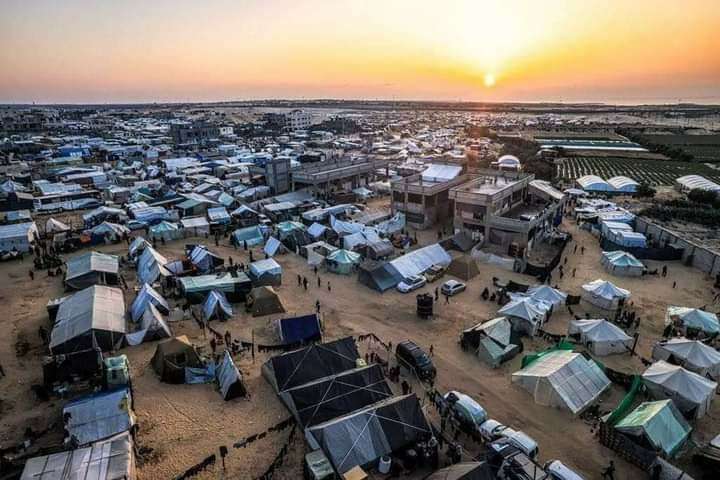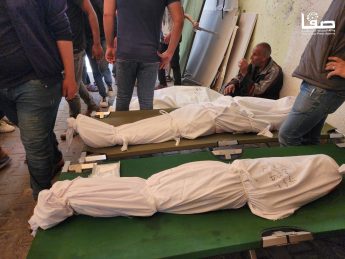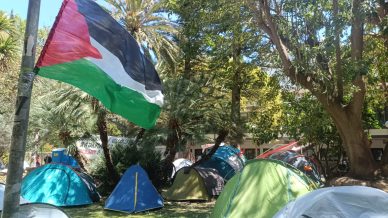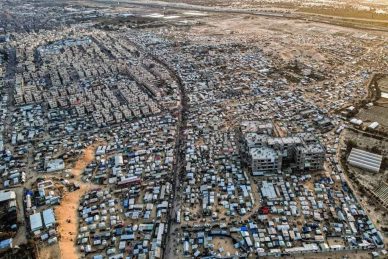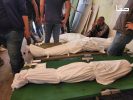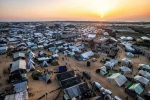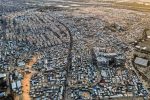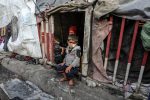GAZA, (PIC)
With the rising temperatures in the Gaza Strip, a new crisis exacerbates the suffering of hundreds of thousands of forcibly displaced people in Gaza due to the ongoing Israeli war of genocide for the past seven months.
Citizen Hassan Radwan (55 years old) began speaking to the PIC correspondent as he struggled to catch his breath due to the intensity of the heat. He said, “Living in a tent is a tragedy in winter and summer, it’s not our fate to die in it a thousand times a day.”
Radwan continued describing the tent as a blazing furnace amidst the scorching heat that hits the Gaza Strip. He confirmed that his tent, set up off the coast of Deir Al-Balah city in central Gaza Strip, has turned into a real oven.
A ruthless war
Since October 7th of last year, Israeli occupation forces have been waging a ruthless war against the Gaza Strip, resulting in more than 120,000 martyrs, wounded, and missing persons, in addition to the destruction of at least 60% of residential buildings, infrastructure, institutions, and universities, and the displacement of hundreds of thousands of people.
Anyone passing by the road from the Nuseirat camp to Rafah in the southernmost part can see overcrowded tents filled with displaced people who have lost all the essentials of human life, further intensifying their miserable reality and exacerbating their suffering.
In the vicinity of the asphalt in the Tel al-Sultan neighborhood, a citizen named Akram Al-Haddad ,42 years old, holds a piece of cardboard and tries to bring some cold air for himself and his child, but his attempt fails. The intense heat dominates the scene, increasing its darkness, misery, and harshness. He told our correspondent, “I swear to God, we can’t sleep because of the heat and insects.”
He continues saying that his tent is made of plastic, which collects and emits heat into the place, and all cooling attempts fail. He confirms that the displaced people are deprived of cold fresh water and refreshing air. Every detail of the tent is harsh and indescribable.
“The narrow space, sand, darkness of the night, and the absence of privacy are all terrifying pains, worsened by the harsh heat,” Al-Haddad said.
In one of the streets of Al-Mawasi in Khan Yunis, south of the Gaza Strip, a citizen named Rabee Abid (36 years old) sits near what resembles a tent and says, “I live in a place that can hardly be called a tent. It’s a piece of randomly wrapped cloth. We try to cover ourselves with it amidst the heat, but we can’t sit in it because it’s like a boiling furnace.”
He further wishes to return to his area from which he was displaced in Gaza City, affirming that relief will come and that there will be relief after distress and fatigue.
Our correspondent went on a tour among the tents in the Zawaida area in the middle of the Gaza Strip and witnessed something indescribable. He said that due to the intensity of the heat, he saw exhausted children overwhelmed by fatigue and extreme tiredness, while elderly people were sweating and seeking refuge, moving right and left to escape the hellish conditions of the tent.
Someone says to our correspondent, “I wish I could escape from the heat. The air is hot, the water is hot, and even our beds are hot.”
In the scorching weather that heralds an exceptionally hot summer, getting a cup of cold water is extremely rare. If one of the displaced individuals manages to obtain it, it comes at a high cost just to quench their thirst for an hour. Of course, the overwhelming majority of them cannot afford to bring liters of cold water for themselves and their families, not to mention the impossibility of storing it.
The impact of the blazing temperature in the displacement tents is not limited to the inability to sit in them or the feeling of thirst. It also creates a sense of general discomfort, difficulty breathing, and negatively affects mood, in addition to itching and skin diseases such as eczema.
The Euro-Med Human Rights Monitor confirms that the suffering of Palestinian refugees due to the ongoing Israeli military attack on the Gaza Strip for the seventh consecutive month is witnessing a serious escalation with the rapid rise in temperature and its intensification in the summer, accompanied by dry weather, high humidity rates, and the spread of insects and rodents. This raises concerns about the spread of epidemics and diseases and an increase in the number of deaths as a result.
The Euro-Med Monitor highlights that the deliberate humanitarian catastrophe created by Israel in the Gaza Strip through the destruction of means and aspects of life threatens the lives of Palestinian civilians, especially the vulnerable groups, and exposes them to further serious risks. This is due to the high temperatures and their dire conditions, whether in overcrowded shelters or in nylon tents that lack the basic necessities of life. This is in addition to the effects of malnutrition, dehydration, and fear.
It warns that the scorching temperatures exacerbate the daily misery experienced by Palestinian refugees amid a severe shortage of clean and safe water, and significant environmental risks due to the lack of service facilities, the collapse of sewage systems, and the accumulation of waste. This has led to the rapid spread of infectious diseases and skin allergies.
Deaths from heat
The Commissioner-General of the United Nations Relief and Works Agency for Palestine Refugees (UNRWA), Philippe Lazzarini, revealed on Friday that there are reports of at least two children dying due to the heatwave in the past few days in the Gaza Strip.
Lazzarini stated that “Gaza has experienced an unusual heatwave in recent days, exacerbating the inhumane living conditions.”
The Euro-Med Monitor has documented several deaths resulting from the humanitarian and health crisis in the Gaza Strip, as the suffering of the displaced in camps and shelters intensifies with the heatwaves and the spread of epidemics and diseases, particularly among children and vulnerable groups.
Among the victims is 5-month-old Malak Sa’id Al-Yaziji, who died on April 25th after being forcibly displaced with her family to the city of Rafah in the southern Gaza Strip. The family resided in a displacement tent that was affected by extreme heat, as the nylon tents lacked the basic necessities of life and suffered from water scarcity.
Sa’id Khalil Al-Yaziji, the 40-year-old father of the deceased child, told the Euro-Med Monitor team that they were displaced from their residential area in Beit Hanoun town in the early days of the Israeli military attack. They first moved to the Nuseirat refugee camp in central Gaza, and then to Rafah in the southern part of the Strip.
He mentioned that they had been living in a tent in Rafah since December 23rd, three days after the birth of Malak. Prior to her severe deterioration, the child did not show any signs of health issues. She was taken to the Emirati field hospital where her death was announced. Her body was then taken to the Abu Yousef Al-Najjar Hospital, which issued a report stating that her death was due to the high temperatures and severe weakness in heartbeats.
The Euro-Med Monitor also received information about the death of 19-year-old Lara Grace Al-Sayegh on April 25th. She died while attempting to flee with her mother from Gaza City to Rafah, affected by the extreme temperatures. Her mother also fell into a coma for the same reasons.
The Euro-Med Monitor has highlighted that tens of thousands of Palestinian civilians are now more threatened than ever by the spread of deadly diseases, health hazards, and contagious diseases due to the increasing heat and the ongoing Israeli genocide.
The Euro-Med Monitor documented the death of two children due to these conditions. Two-and-a-half-year-old Hoor Iyad Al-Abssi, who was displaced with her family in Rafah, died on April 11th from hepatitis A as a result of pollution, overcrowding, and the worsening of the disease in her body. She was transferred to the European Hospital for five days and died due to complications from her illness and the absence of necessary healthcare.
The Euro-Med Monitor also documented the death of 27-year-old Anas Abdullah Karaz on April 24th. He also contracted hepatitis A during his displacement with his family in Rafah.
Dr. Ahmed Al-Naqris, an internist at the Abu Yousef Al-Najjar Hospital in Rafah, stated that hepatitis A is spreading at unprecedented rates due to the harsh conditions and severe population density, particularly in Rafah. In the past four weeks alone, 5 to 6 cases of hepatitis A are being recorded daily in a single health center in Rafah, attributed to the contamination of drinking water, the spread of sewage among displaced people, overcrowding, lack of hygiene, and poor nutrition. Dehydration, vomiting, and diarrhea are among the symptoms observed, and the symptoms worsen rapidly among patients due to the lack of necessary healthcare provisions, the severe strain on hospitals and medical facilities, and the accumulation of solid waste throughout the Gaza Strip.
In addition to the ongoing military attacks by the Israeli army by air, land, and sea, the people of Gaza are also facing the threat of epidemics and infectious diseases due to contaminated water, overcrowding, high temperatures, the collapse of the healthcare system, limited healthcare services including patient isolation to prevent the spread, the shortage of medications and sterilization supplies, and the spread and accumulation of solid waste throughout the Gaza Strip.
Hundreds of thousands of displaced people in Rafah are hoping for a glimmer of hope to return to their homes in other governorates, even though many believe that their homes have been completely or partially destroyed. They see returning to a pile of rubble as a better option than the hardships of displacement, which carry many tragedies.
This desired return is one of the primary conditions insisted upon by resistance factions, particularly Hamas, who believe that the return of the displaced is linked to a comprehensive cessation of aggression and the complete withdrawal of occupation forces from the Gaza Strip.
The rapid rise in temperature, accompanied by dry weather, increased humidity, and the proliferation of insects and rodents, has led the Euro-Med Human Rights Monitor to warn about the widening spread of epidemics and diseases, resulting in an increasing number of deaths.

